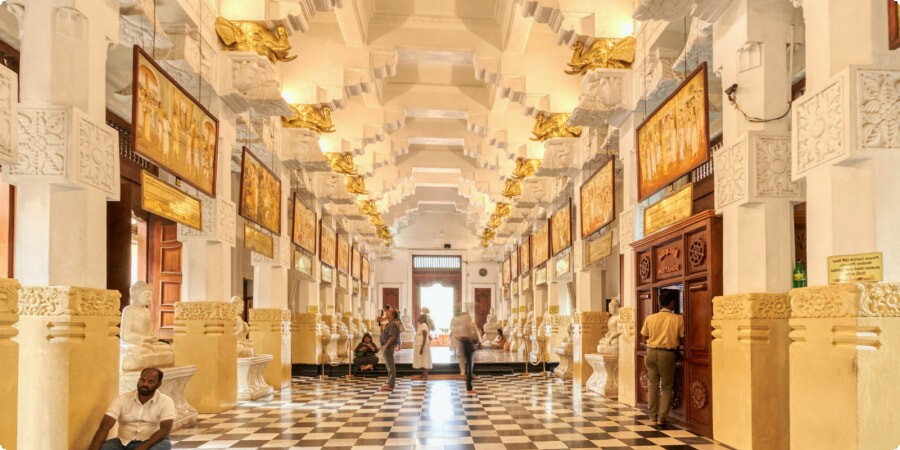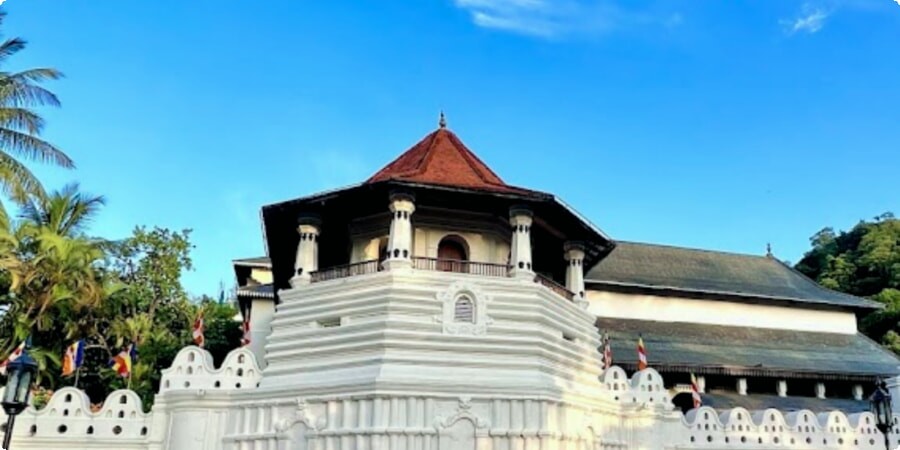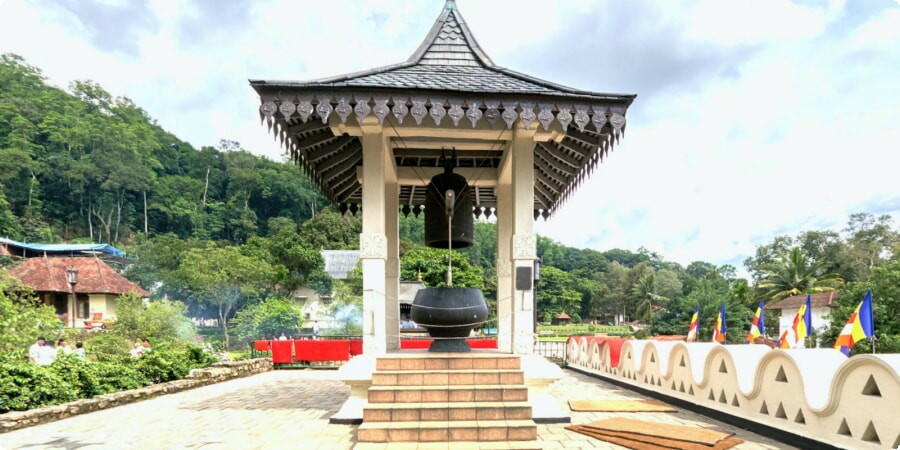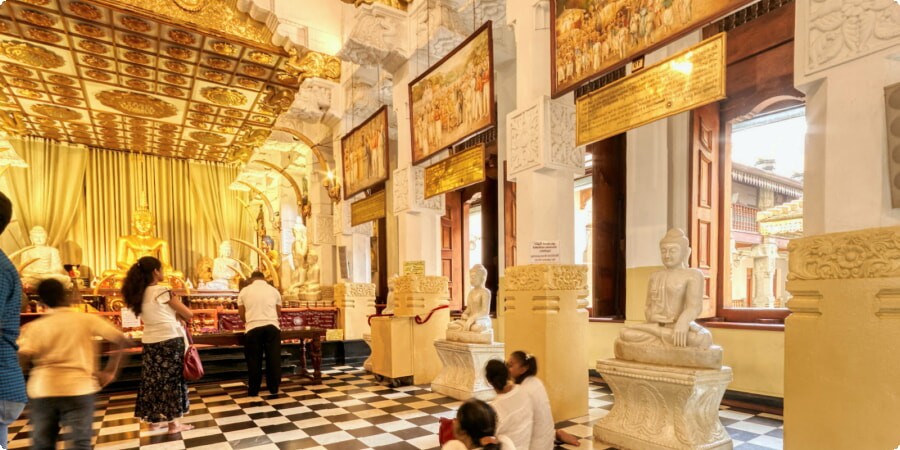In the Heart of Kandy: The Temple of the Tooth and Its Connection to Sri Lankan Identity
Nestled amid the lush landscapes and cultural tapestry of Kandy, the Temple of the Tooth stands as a testament to the profound connection between architecture, spirituality, and the identity of Sri Lanka. As we embark on this journey, envision the beating heart of Kandy, where the echoes of ancient rituals and the architectural grandeur of the temple intertwine to shape the very soul of the nation.
Historical Foundations
To understand the essence of the Temple of the Tooth, we must peel back the layers of time and explore its historical foundations. Rooted in the rich soil of Sri Lanka's past, the temple's origins date back centuries. Initially built to house the sacred tooth relic of the Buddha, it became a sanctuary and a symbol of protection for the island nation. Throughout the ages, the temple has withstood the tests of time, emerging not just as a physical structure but as a living chronicle of Sri Lanka's history.
As we navigate through the historical corridors of the temple, we unravel tales of devotion, invasions, and reconstructions, each chapter contributing to the narrative of the temple's significance in shaping Sri Lankan identity.
For a deeper dive into the historical foundations of the Temple of the Tooth, explore Wikipedia.

Architectural Grandeur
Approaching the Temple of the Tooth is like stepping into a realm where spirituality meets artistic brilliance. The architectural grandeur of the temple is a spectacle to behold. Intricate carvings, majestic spires, and ornate details adorn the structure, reflecting a harmonious fusion of Sri Lankan, Indian, and Thai architectural influences.
The temple complex is not merely a physical space but a canvas that showcases the profound artistic expression of generations past. Stand before the towering entrance, adorned with mythical figures and guardian deities, and you'll feel the weight of history and the cultural richness woven into the very fabric of the temple's design.
Explore the architectural wonders of the Temple of the Tooth on Google Maps.
In the upcoming section, we'll delve deeper into the religious significance of the Temple of the Tooth, exploring the rituals, ceremonies, and the revered tooth relic that form the spiritual nucleus of this cultural landmark. For those planning to explore Sri Lanka beyond Kandy, consider the convenience of booking a car at Colombo Airport through this link for a seamless journey through the landscapes of this enchanting island.

Religious Significance
As we step into the inner sanctum of the Temple of the Tooth, the air is laden with spirituality and reverence. The heart of the temple houses the sacred tooth relic of the Buddha, a revered artifact that holds immense religious significance. For Sri Lankan Buddhists, the relic represents a connection to the Buddha himself and serves as a symbol of protection and prosperity.
The rituals and ceremonies conducted at the temple amplify its religious importance. Daily worship, processions, and traditional performances contribute to the vibrant spiritual atmosphere. The Temple of the Tooth isn't just a place of worship; it's a living testament to the enduring Buddhist heritage that permeates the core of Sri Lankan identity.
Cultural Traditions and Festivals
Throughout the year, the Temple of the Tooth becomes a focal point for cultural celebrations and festivals. One such prominent event is the Esala Perahera, a grand procession that captivates both locals and visitors alike. During this annual festival, the streets of Kandy come alive with the rhythmic beats of drums, the graceful movements of traditional dancers, and the majestic procession of adorned elephants.
The Esala Perahera is a spectacle that transcends religious boundaries, uniting people from diverse backgrounds in celebration. The vibrant traditions and festivals associated with the Temple of the Tooth contribute to the cultural mosaic that defines Sri Lanka, fostering a sense of unity and shared identity.

Connection to Sri Lankan Identity
The Temple of the Tooth isn't merely a historical or religious site; it is an integral part of Sri Lankan identity. Its presence shapes the collective consciousness of the nation, instilling a sense of pride and belonging. The temple's enduring significance extends beyond its religious and cultural aspects to influence art, literature, and societal values.
Sri Lankans, whether in Kandy or beyond, view the Temple of the Tooth as a custodian of their heritage. It stands as a reminder of the resilience of the nation, having withstood the trials of time and external forces. The connection between the temple and Sri Lankan identity is a testament to the profound impact that cultural landmarks can have on shaping a nation's narrative.
For those inspired to explore the cultural richness of Sri Lanka, including the Temple of the Tooth and beyond, consider the convenience of booking a car through this link. Having a rental car provides the freedom to navigate the diverse landscapes of this island nation, from the historic sites of Kandy to the pristine beaches of the south.
Pilgrimage Experience
Embarking on a pilgrimage to the Temple of the Tooth is a deeply personal and spiritual journey. The air is infused with a sense of devotion as pilgrims, both local and international, make their way to this sacred site. The experience is not just a physical exploration of the temple's architecture but a soulful quest for connection and enlightenment.

As you walk through the hallowed halls, observe the rituals, and stand in the presence of the revered tooth relic, a profound sense of tranquility envelops you. The pilgrimage experience at the Temple of the Tooth is a unique blend of cultural immersion and spiritual introspection, leaving a lasting impression on the hearts of those who seek solace and connection.
Conservation and Preservation Efforts
Preserving the sanctity and structural integrity of the Temple of the Tooth is a responsibility shouldered by custodians and conservationists. The passage of time, environmental factors, and increased visitation pose challenges to the preservation of this cultural gem. Efforts are underway to implement conservation measures, ensuring that future generations can continue to experience the spiritual and historical significance of the temple.
Conservation initiatives include careful restoration of delicate artwork, controlled visitor access to sensitive areas, and the use of advanced technologies to monitor the structural health of the temple. These efforts aim to strike a delicate balance between making the site accessible to the public and safeguarding its cultural and religious sanctity.
Contemporary Relevance
In the bustling landscape of modern Sri Lanka, the Temple of the Tooth retains its timeless relevance. Beyond being a historical relic, the temple actively contributes to contemporary life in Kandy and the nation at large. It serves as a focal point for cultural events, educational programs, and spiritual gatherings that bridge the gap between tradition and the present.
The contemporary relevance of the Temple of the Tooth extends beyond religious boundaries. It acts as a cultural ambassador, welcoming people from diverse backgrounds to partake in its rich tapestry of rituals and festivals. As Sri Lanka continues to evolve, the temple stands as a symbol of continuity, resilience, and the enduring spirit of a nation proud of its heritage.
For those captivated by the allure of Sri Lanka's cultural and historical treasures, including the Temple of the Tooth, consider the convenience of booking a car through this link. A rental car provides the flexibility to explore not only Kandy but also the scenic landscapes, ancient ruins, and vibrant cities that define the diverse and enchanting island of Sri Lanka.